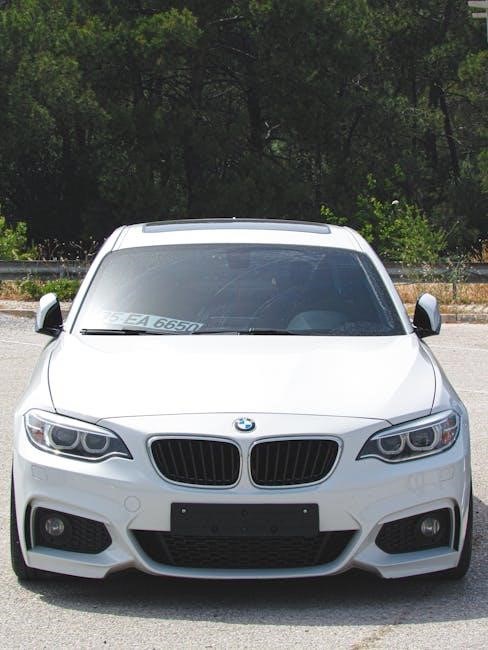bmw 1 series owners manual
Download the official BMW 1 Series owner's manual. Discover key features, specifications, and maintenance tips for your vehicle. Your UK guide to optimal performance.
Welcome to the BMW 1 Series Owner’s Manual, your comprehensive guide to understanding and mastering your vehicle. This manual provides detailed instructions for safe operation, maintenance, and troubleshooting, ensuring optimal performance and longevity of your BMW.
1.1 Overview of the Manual
This manual is designed to provide owners with a comprehensive understanding of their BMW 1 Series, covering essential information for safe and efficient operation. It spans over 300 pages, detailing everything from technical specifications to maintenance schedules. The guide includes instructions for oil level checks, troubleshooting common issues, and utilizing advanced features like the interactive Owner’s Handbook. Available for various models, including the 2008, 2009, 2010, 2011, and 2013 editions, the manual ensures compatibility across different generations of the BMW 1 Series. Whether you’re familiar with BMW vehicles or new to the brand, this manual serves as an invaluable resource. It is available in both printed and digital formats, with the digital version offering interactive features for enhanced user experience. By following the guidelines outlined, you can maximize your vehicle’s performance, safety, and longevity. This manual is your ultimate companion for owning and maintaining a BMW 1 Series.
1.2 Importance of Reading the Manual
Reading the BMW 1 Series Owner’s Manual is crucial for ensuring safe and proper operation of your vehicle. This comprehensive guide provides detailed instructions for understanding your car’s technical features, maintenance requirements, and troubleshooting procedures. By familiarizing yourself with the manual, you can optimize performance, prevent potential issues, and ensure longevity. The manual covers essential topics such as oil level checks, tire pressure, and safety precautions, all of which are vital for responsible ownership. Additionally, it offers insights into advanced systems like the interactive Owner’s Handbook, helping you make the most of your driving experience. Whether you’re a new or experienced owner, this manual serves as an indispensable resource. Neglecting to read it may lead to misunderstandings or improper use, potentially compromising safety and vehicle condition. Therefore, taking the time to thoroughly review the manual is a key part of responsible BMW ownership.
1.3 Key Features of the BMW 1 Series
The BMW 1 Series is renowned for its dynamic performance, sleek design, and advanced technology. It offers a range of powerful engine options, including diesel and petrol variants, ensuring a thrilling driving experience. The manual highlights features like precise handling, responsive steering, and superior acceleration, making it a joy to drive. Inside, the car boasts a premium interior with ergonomic controls and cutting-edge infotainment systems. Safety is prioritized with advanced driver-assistance systems, such as stability control and collision warning. The 1 Series also features fuel-efficient technologies, minimizing emissions while maintaining performance. Whether you’re navigating city streets or enjoying open roads, this vehicle is designed to deliver comfort and excitement. Customizable options allow owners to tailor their driving experience, enhancing both functionality and personal style. Explore these features in detail within the manual to maximize your BMW 1 Series ownership experience.
1.4 Safety Precautions
Your safety and the safety of others are paramount when operating the BMW 1 Series. Always wear a seatbelt, and ensure all passengers do the same, as it significantly reduces the risk of injury in the event of an accident. Airbags are designed to deploy in conjunction with seatbelts, so never modify or deactivate them. Keep loose objects secure in the vehicle to prevent them from becoming projectiles during sudden stops or collisions. Avoid overloading the car, as it can compromise handling and braking performance. Familiarize yourself with warning lights on the instrument cluster, as they indicate critical system issues that require immediate attention. Never ignore safety advisories or warnings provided by the vehicle’s systems. Regularly inspect tires, brakes, and suspension to ensure optimal safety. Always follow proper procedures for child seat installation and use the ISOFIX mounting points if available. By adhering to these precautions, you can minimize risks and enjoy a safer driving experience in your BMW 1 Series.

Technical Specifications and Vehicle Overview

This section provides an overview of the BMW 1 Series’ technical specifications, including engine options, dimensions, and key features that define its performance and design capabilities.

2.1 Engine and Performance
The BMW 1 Series offers a range of powerful and efficient engine options, including petrol and diesel variants. Petrol engines feature BMW’s TwinPower Turbo technology, delivering exceptional power and reduced emissions. Diesel engines provide impressive torque for smooth acceleration. The lineup includes engines ranging from 1.5-liter 3-cylinder units to 2.0-liter 4-cylinder configurations, ensuring a balance of efficiency and performance. With outputs ranging from approximately 116 horsepower to 301 horsepower in high-performance models, the 1 Series caters to diverse driving preferences. The combination of lightweight design and precise engineering enhances agility and responsiveness. Whether navigating urban roads or highways, the BMW 1 Series delivers a dynamic driving experience. Advanced features like automatic start/stop and Eco Pro mode further optimize fuel efficiency without compromising on power.
2.2 Transmission and Drivetrain
The BMW 1 Series is equipped with advanced transmission systems designed for seamless power delivery and optimal performance. The available options include a precise 6-speed manual transmission and an 8-speed Steptronic automatic transmission, offering smooth shifting and responsive acceleration. The manual transmission provides a sporty, driver-focused experience, while the automatic version includes paddle shifters for added control. Rear-wheel drive (RWD) is standard, delivering the hallmark BMW driving dynamics, while xDrive all-wheel drive is available for enhanced traction and stability in various driving conditions. The drivetrain is engineered to maximize efficiency and performance, with features like coasting in neutral and intelligent transmission management. This ensures a balance between sporty agility and everyday practicality, making the BMW 1 Series adaptable to diverse driving scenarios. The combination of transmission and drivetrain technologies enhances both fuel efficiency and driving enjoyment.
2.3 Dimensions and Capacities
The BMW 1 Series is designed to offer a perfect blend of compact agility and practicality. Its exterior dimensions include a length of approximately 4,433 mm, a width of 1,799 mm, and a height of 1,434 mm, with a wheelbase of 2,670 mm. The luggage compartment offers a minimum capacity of 380 liters, expandable to 1,200 liters with the rear seats folded. The fuel tank capacity is 52 liters, ensuring a comfortable range for both city and long-distance driving. The vehicle’s curb weight varies depending on the model, ranging from 1,400 kg to 1,600 kg. The gross vehicle weight rating (GVWR) is approximately 1,930 kg, while the payload capacity is around 450 kg. These dimensions and capacities ensure the BMW 1 Series is versatile, accommodating passengers and luggage effortlessly while maintaining its sporty character. The balanced proportions enhance both functionality and dynamic handling.

Operating the BMW 1 Series
Operating the BMW 1 Series involves mastering essential systems for a smooth driving experience. Familiarize yourself with the instrument cluster, controls, and driver assistance features to ensure safe and efficient operation.
3.1 Instrument Cluster and Controls
The BMW 1 Series instrument cluster provides essential vehicle information at a glance. It features a high-resolution display with customizable settings, showing speed, engine rpm, fuel level, and navigation data. The controls are intuitively designed, with the steering wheel-mounted buttons allowing easy access to functions like cruise control and infotainment. The center console houses key controls for heating, ventilation, and air conditioning, ensuring comfort and convenience. Additional switches for features like fog lights and driver assistance systems are located within easy reach on the dashboard. Familiarizing yourself with these controls enhances your driving experience, ensuring seamless operation of the vehicle’s advanced systems. Always refer to the manual for detailed instructions on customizing settings and optimizing functionality.

3.2 Infotainment and Navigation Systems
The BMW 1 Series features a cutting-edge infotainment system designed for seamless connectivity and entertainment. The high-resolution touchscreen display at the center of the dashboard provides access to a wide range of functions, including Bluetooth connectivity, USB interfaces, and smartphone integration via Apple CarPlay and Android Auto. The iDrive operating system allows intuitive navigation through menus, while voice command functionality enables hands-free control of music, calls, and navigation. The optional navigation system includes real-time traffic updates and turn-by-turn directions, ensuring accurate route guidance. Customizable favorites and split-screen views enhance user convenience. Additional features such as DAB radio, CD playback, and optional wireless charging further elevate the driving experience. Familiarizing yourself with these systems will help you maximize comfort and connectivity while on the road.
3.3 Driver Assistance Systems
The BMW 1 Series is equipped with advanced driver assistance systems to enhance safety and convenience. The Active Cruise Control with Stop & Go function automatically adjusts your speed to maintain a safe distance from the vehicle ahead, even in heavy traffic. Lane Departure Warning alerts you if the vehicle drifts out of its lane without signaling, while Automatic Emergency Braking intervenes to prevent or mitigate collisions. Parking Assistant simplifies maneuvering into tight spaces by automatically steering the vehicle during parallel or perpendicular parking. Additionally, features like Traffic Jam Assistant and Speed Limit Information provide added support during challenging driving conditions; These systems work seamlessly to reduce driver fatigue and improve overall road safety. It is essential to familiarize yourself with these technologies through practice and consultation of the manual to maximize their benefits.

Maintenance and Servicing
Regular maintenance is crucial for preserving your BMW 1 Series’s performance and longevity. Adhere to the recommended service schedule, and address any issues promptly to ensure reliability and safety.
4.1 Scheduled Maintenance Intervals

Your BMW 1 Series requires regular servicing to maintain optimal performance and reliability. Follow the recommended maintenance schedule outlined in your owner’s manual. Typically, your vehicle should be serviced every 12,000 to 15,000 miles or once a year, depending on driving conditions. Key checks include oil and filter changes, tire inspections, brake system evaluation, and battery health. The vehicle may also alert you through the Service Interval Indicator in the instrument cluster. Adhering to these intervals ensures your BMW remains in peak condition, prevents potential issues, and maintains warranty validity. Always consult a certified BMW service center for precise scheduling tailored to your driving habits and local conditions. Proper maintenance not only enhances your driving experience but also preserves the longevity of your vehicle.
4.2 Oil and Fluid Levels
Regular checks of your BMW 1 Series’ oil and fluid levels are essential for maintaining its performance and longevity. Locate the bonnet release lever under the driver’s side dashboard and ensure the vehicle is on a level surface. The engine oil level can be checked electronically via the Control Display or traditionally using the dipstick. Other fluids, such as coolant, brake fluid, and windshield washer fluid, should also be inspected periodically. Always use BMW-approved products to ensure compatibility and optimal performance. If any fluid level is low, replenish it as instructed in the manual. Avoid overfilling, as this can cause damage. If you’re unsure about the process, consult a BMW service professional. Regular fluid checks help prevent engine damage and ensure your vehicle runs smoothly. Always refer to the recommended specifications in your manual for accurate guidance.
4.3 Tire Pressure and Condition
Proper tire pressure and condition are critical for the safety, handling, and fuel efficiency of your BMW 1 Series. Check tire pressure monthly and before long trips, using a reliable pressure gauge; The recommended pressure can be found on the tire information placard on the driver’s side door pillar or in your manual. Under-inflated tires can lead to reduced traction, increased wear, and higher fuel consumption. Inspect tires regularly for signs of wear, such as uneven tread, cracks, or bulges. Replace tires when the tread depth reaches the minimum level (1.6 mm). Always use tires of the same type and size as specified by BMW. If you notice vibrations or uneven wear, have your wheels balanced and aligned by a professional. Proper tire maintenance ensures optimal performance, safety, and longevity of your vehicle. Always adhere to the guidelines provided in your owner’s manual for precise instructions.

4.4 Battery Care and Maintenance
Proper care and maintenance of your BMW 1 Series battery are essential to ensure reliable starting power and electrical system functionality. Avoid deep discharging the battery, as this can reduce its lifespan. Always keep the battery terminals clean and secure, and check for any signs of corrosion. If corrosion is present, clean the terminals with a wire brush and apply a protective layer of petroleum jelly. When charging the battery, use a BMW-approved charger to avoid damage to the electrical system. Never overcharge the battery, as this can cause permanent damage. If the battery is more than five years old, have it tested by a BMW service technician. In cold weather, ensure the battery is fully charged to maintain performance. Always follow the manufacturer’s guidelines for battery replacement and maintenance to ensure optimal reliability and longevity of your vehicle’s electrical system.

Troubleshooting Common Issues
This section provides guidance on identifying and resolving common issues with your BMW 1 Series. Consult the manual for specific solutions, and seek professional assistance if problems persist.
5.1 Diagnostic Warning Lights
The BMW 1 Series is equipped with a sophisticated warning light system to alert drivers of potential issues. These lights, located on the instrument cluster, illuminate in various colors to indicate different levels of urgency. Red lights signify critical issues that require immediate attention, such as engine or braking system malfunctions. Yellow or orange lights indicate less urgent concerns, like low oil levels or tire pressure warnings. Green or blue lights typically signal operational statuses, such as the activation of driving aids or system checks. If a warning light appears, consult the manual to understand its meaning and take appropriate action. Ignoring these indicators may lead to more severe problems. Always refer to the manual or contact a BMW service center for professional assistance. Regular checks and timely responses ensure optimal vehicle performance and safety.
5.2 Common Issues and Solutions
Like any vehicle, the BMW 1 Series may experience occasional issues. One common problem is engine oil leaks, often caused by worn gaskets or seals. Regular inspections during servicing can help identify and resolve this early. Another issue is faulty electronic systems, such as malfunctioning infotainment screens or unresponsive controls. Resetting the system or updating software usually resolves these glitches. Additionally, some owners report uneven tire wear, which can be addressed by aligning the wheels and checking tire pressures regularly. If the car pulls to one side while driving, it may indicate misaligned wheels or uneven brake wear. Consulting the manual or visiting a certified BMW technician is recommended for accurate diagnoses and repairs. Addressing these issues promptly ensures reliability and maintains the vehicle’s performance. Always prioritize professional advice for complex problems to avoid further damage. Regular maintenance is key to preventing these issues.

